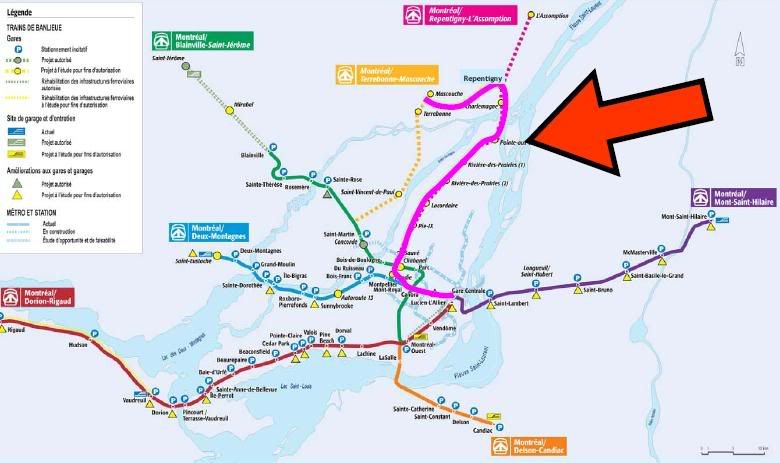G
green22
Guest
Official visit to Paris: Gerald Tremblay is seduced by Parisian tramways:
www.ledevoir.com/2006/02/21/102576.html
Interesting points from article:
--Paris
Parisiens using public transit: 70%
Paris suburbanites using public transit: 60%
Percentage of auto parking that is free: 0% (last free public parking eliminated)
Reduction of auto traffic in the last 4 years: 14%
Parisiens in favour of LRT: 69%
Mayor of Paris has systematic campaign to take roadspace away from vehicles, when he became mayor 96% of roadspace was dedicated to cars/trucks.
17 bus routes of 59 will be in reserved lanes (does not include reserved streetcar lanes).
Paris has built and will continue building tramways.
--Montreal
Predicted cost of LRT line: $50 million / km
Savings over a metro line: 50%
3 proposed tramway projects:
Jean Talon station (blue line) to old montreal by Avenue du Parc
Rue Notre Dame from the centre to end of the island.
Peel basin to subway (Port agency project coincides with changing elevated Bonavenure freeway into a street)
www2.ccnmatthews.com/scri...7051n.html
--Toronto (for comparison)
Cost of a streetcar line in reserved lanes: $15 million / km
Cost of a tunneled subway line: $160-200 million / km
I think one should be careful when looking at subway/streetcar/bus right-of-way costs on a general basis. It really depends on the line itself. For example the conversion of St. Clair already replaced exiting tracks, no need to mess with underground utilities or build new underground station at St. Clair West. Is it a streetcar line like Queen street, in the centre of the street like Spadina, or along a railroad track like blue22? Are stations or sections be underground or elevated? Will new right-of-way need to required?
London and Paris seem to be competing for most sustainable, vibrant status. I haven't been to either city so won't speculate on who's ahead, but there are definitely some important lessons for other cities. Miller went to London and now Tremblay to Paris. It's really tough trying to create a sustainable city when upper levels of government are following typical north american sprawl policies. Our suburbs are no where near 60% transit use and current policies will do nothing to change this. One of the main forms of transit in our suburbs (GO rail) is increasingly dependent on car use just in order to be accessed.
www.ledevoir.com/2006/02/21/102576.html
Interesting points from article:
--Paris
Parisiens using public transit: 70%
Paris suburbanites using public transit: 60%
Percentage of auto parking that is free: 0% (last free public parking eliminated)
Reduction of auto traffic in the last 4 years: 14%
Parisiens in favour of LRT: 69%
Mayor of Paris has systematic campaign to take roadspace away from vehicles, when he became mayor 96% of roadspace was dedicated to cars/trucks.
17 bus routes of 59 will be in reserved lanes (does not include reserved streetcar lanes).
Paris has built and will continue building tramways.
--Montreal
Predicted cost of LRT line: $50 million / km
Savings over a metro line: 50%
3 proposed tramway projects:
Jean Talon station (blue line) to old montreal by Avenue du Parc
Rue Notre Dame from the centre to end of the island.
Peel basin to subway (Port agency project coincides with changing elevated Bonavenure freeway into a street)
www2.ccnmatthews.com/scri...7051n.html
--Toronto (for comparison)
Cost of a streetcar line in reserved lanes: $15 million / km
Cost of a tunneled subway line: $160-200 million / km
I think one should be careful when looking at subway/streetcar/bus right-of-way costs on a general basis. It really depends on the line itself. For example the conversion of St. Clair already replaced exiting tracks, no need to mess with underground utilities or build new underground station at St. Clair West. Is it a streetcar line like Queen street, in the centre of the street like Spadina, or along a railroad track like blue22? Are stations or sections be underground or elevated? Will new right-of-way need to required?
London and Paris seem to be competing for most sustainable, vibrant status. I haven't been to either city so won't speculate on who's ahead, but there are definitely some important lessons for other cities. Miller went to London and now Tremblay to Paris. It's really tough trying to create a sustainable city when upper levels of government are following typical north american sprawl policies. Our suburbs are no where near 60% transit use and current policies will do nothing to change this. One of the main forms of transit in our suburbs (GO rail) is increasingly dependent on car use just in order to be accessed.





